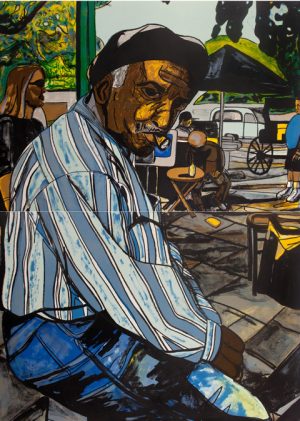Willie Birch is a visual artist working across drawing, painting, and sculpture. With a career spanning over four decades, Birch has established himself through works that vividly portray New Orleans and its everyday inhabitants, often focusing on the overlooked members of his community. He reflects, “A major function of my art is to serve as a historical record of my times. My work is rooted in the notion that art can provoke social change.”
Birch’s work is included in the public collections of the Metropolitan Museum of Art, New York, NY; Whitney Museum of American Art, New York, NY; New Orleans Museum of Art, New Orleans, LA; Crystal Bridges Museum of American Art, Bentonville, AR; Ogden Museum of Southern Art, New Orleans, LA; and the Speed Museum, Louisville, KY among others.
This body of work comes out of a need to create works that are narrative, accessible, and emotionally connected in a direct way to the people they portray. As an artist who is committed to cultural history, I think these works act as visual commentaries that reconstruct our perception of race and class in America. In 1994, I moved from New York back to New Orleans, where I was born and raised. In late 1997, I began to create a series of portraits of people in my neighborhood in order to offset the many derogatory images on display in the New Orleans French Quarter. Stores offered degrading posters, figurines and cards; and street performers used buffoonery to present stereotypical characters. As I developed my ideas for this new body of work, I was struck by the vast differences between the two New Orleans that I know. One is the French Quarter, where most “whites” feel less threatened because they are usually seen as the majority and where it’s easy to walk away feeling that everybody is always happy and fun-loving in the “Big Easy.” Many of these visitors never question the French Quarter’s images of African Americans. Then there is the city-at-large that most tourists don’t wish to-and never do-venture into. In this New Orleans, seventy percent of the residents are of African ancestry and the governing body–the Mayor, the Police Commissioner, the Fire Commissioner, the CEO, and the Superintendent of Education-is predominantly African American. Here you see racial pride displayed openly during public and private events. Here complexion and education are major factors in determining class status. Interracial relationships are discouraged by both blacks and whites, the rate of black-on-black crime is extremely high, the majority of the people residing in the city live below the poverty line, and America’s most intellectual music, called Jazz, was created by people of African ancestry. These two contradictory images of New Orleans offered me the opportunity to visualize a body of work that addressed the idea of perception and how we as human beings continue to create, perpetuate, and define peoples as the “other”, and what that implies in a changing society.
-Willie Birch
More Information
Artist Website
Bomb Magazine

